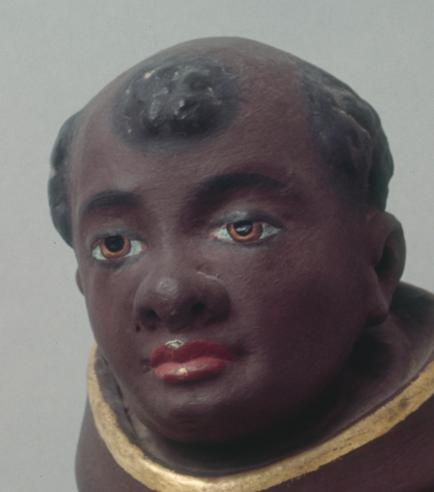Historical commentary. The pious figure of a black person is often presented as a subsidiary figure within religious works of early-modern Europe. In the case of St. Benedict of Palermo, however, a man of African descent stands as the full focus of religious devotion. How this humblest of souls attained such an enduring sanctity reveals nothing less than the perseverance under oppression exhibited by his black followers during the long time of trial that lay ahead.
Though monumental in conception, the robust figure of the black saint stands only about 2 feet high. It is carved of wood, then gilded and painted. Pupils of glass complete the effect of living faith. He stands on the altar of a chapel dedicated to the Virgin Mary in Aradas, a small town located in the north-central coastal region of Portugal.
He wears the robe and knotted belt typical of the Franciscan order of mendicant monks. The richly gilded borders of his mantle accentuate its heavy form with a lively pattern of linear movement. In one hand he holds a colorful bouquet of roses, and in the other, a tightly grasped piece of cloth, both signs of the prodigious acts of faith performed as demonstrations of his steadfast piety and concern for the poorest of his fellow human beings.
Benedict was born to a couple brought from Africa to serve a Sicilian master. Though his father, and perhaps his mother as well, were slaves, he himself seems to have been born free. Born between 1526 and 1528, he joined a group of nonprofessed members of a Franciscan hermit community at San Fradello, located farther north on the island, when he was still young.
Following a general edict from the pope, he was required to enter a monastery of the order. There, his humility and devotion to his duties led to his selection as the group’s superior, despite his low official rank, as a lay brother, and his inability to read.
His acts of kindness both within and beyond the confines of the monastery won him wide acclaim and even veneration by those who emulated his example. After long decades of witness to the faith, Benedict died in 1589. Despite the universal regard of his followers, he was not canonized until 1807.
Benedict’s veneration rapidly spread and became especially popular in Portugal and Spain. His unusual status as a holy black man was especially attractive to the growing population of African slaves in the Iberian peninsula. Ironically, it was this very appeal that was used by ecclesiastical and royal authorities to their own advantage. By assimilating the slaves into the Catholic Church, their lives within the continually expanding New World colonies could be more effectively regulated.
In a more enlightened process of inclusion, Benedict’s contemporaries struggled with the issue of his sanctity as a black man. Confronting them was nothing less than the weight of centuries of theological exegesis associating any kind of blackness with spiritual corruption and evil. Through the employment of bold, new metaphorical contrasts in both literature and theology as well as in the arcane practice of alchemy, scholars of the time found a hidden virtue in blackness.
In the writings of Benedict’s near contemporary Alonso de Sandoval, the perceived dark inferiority of the African, so like coal, was ultimately likened to the overpowering brilliance of diamonds. Such profound sublimation of this common substance was equated with the transformative power of the Holy Spirit, which, according to Sandoval, radiated from the spirit of St. Benedict “as a white beacon among the religious of the time, surpassing all of them in spirituality.” Sandoval spoke from the heart, since he had spent years in pious ministry among the recently arrived African slaves at the New World port of Cartagena. He and his successor, Peter Claver, though white, acted as Benedict’s surrogate, living lives of self-denial in emulation of the saint’s guiding example.
It was at this point that the formal veneration of Benedict began in earnest. Its spread was especially rapid among the black slaves of the Iberian peninsula, and from there to the New World colonies of Spain and Portugal. With the extension of his cult came the necessity of an authoritative visual aspect to which the faithful could direct their devotions.
It was the solid, three-dimensional approach of the sculptor that gave the saint his definitive form. Images of Benedict are typically carved from wood and painted. Few examples are carved from more exalted materials, and almost all remain on a relatively small scale.
Though generally remaining small in size, the appearance of St. Benedict underwent significant changes over time. Until the middle of the 18th century, the head of the saint often bore the rays of beatitude. His customary attributes—that is, tangible signs of his life and ministry—also changed. As in this example, at first he bore a basket of roses, a manifestation of his own miraculous multiplication of bread for the poor. These were then replaced by an image of the light-skinned Christ child, an element not previously associated with his life.
St. Benedict’s popularity declined as the full force of slavery was blunted by the rising voices for abolition. In recent times, however, the original mission of Benedict has returned, often in new guises. Long considered the patron saint of African Americans, his veneration has been expanded by the Knights of St. Benedict, a lay charitable organization founded in the late 19th century by black American Catholics. Its widespread network of chapters remains an impressive reminder of the power of the saint to inspire new generations, now free from the bondage of slavery but still faced with many rivers to cross.
The Image of the Black Archive & Library resides at Harvard University’s Hutchins Center for African and African American Research. The founding director of the Hutchins Center is Henry Louis Gates Jr., who is also co-founder of The Root. The archive and Harvard University Press collaborated to create The Image of the Black in Western Art book series, eight volumes of which were edited by Gates and David Bindman and published by Harvard University Press. Text for each Image of the Week is written by Sheldon Cheek. Article courtesy http://www.theroot.com





